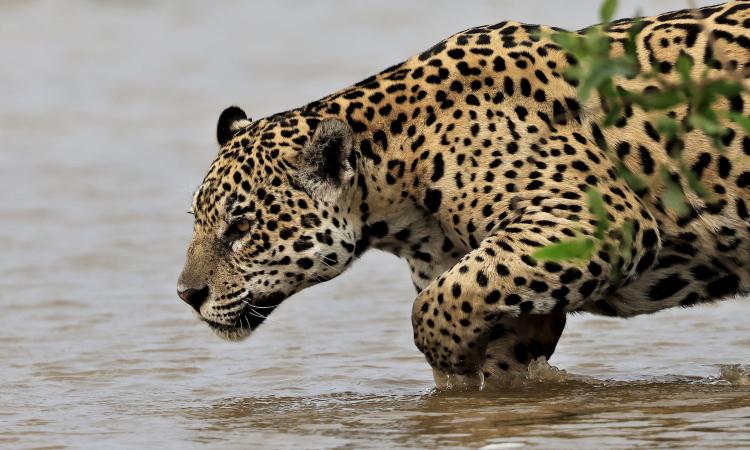Jaguar tourism is about to flourish as the dry season (May-September) approaches in the largest floodplain of the world, the Brazilian Pantanal. Each year, more and more people, mostly foreigners, travel to a few certain locations where jaguars are more easily observed. Although not guaranteed, seeing a jaguar during a boat trip is very likely.

A female jaguar (Panthera onca) by the river
This is particularly the case of Porto Jofre, a very small locality by the Cuiabá River, 250 km far away from Cuiabá, the state capital of Mato Grosso, of which 150 in the unpaved road called Transpantaneira. With the drying of the floodplain during the winter, the jaguars find shelter and food closer to the main rivers, making it easier to observe their behaviour close to the water - eventually even in the waters of the main rivers flowing to the Pantanal.

Jaguar crossing the river
Into the Pantanal
While most tourists head to Porto Jofre almost exclusively for jaguaring, the Pantanal offers much more than that. With an area twice as large as Portugal, the wetland pulses with the water regimes. In the dry season, water is concentrated in the rivers flowing from the adjacent highland, while in the wet season, water extrapolates channels and inundates the whole floodplain.

Overview of the Pantanal wetland in the beginning of the wet season
This water regime influences the whole biota of the Pantanal. The flora is adapted to floods and the fauna is more dispersed in the wet season. When the Pantanal starts drying, usually around April, the rich fauna move closer to the main channels, making it great for wildlife observation with boat tours, especially for birdwatching as almost 700 bird species are known to occur in the Pantanal - of which the Tuiuiú (Jabiru mycteria) is the most iconic and symbol of the region.
However, it is precisely in the dry season that the Pantanal has been impacted by higher environmental pressure from climate change. More and more intense droughts are transforming the landscape, making the environment extremely susceptible to fire. From 2019 to 2023, almost 40% of the Pantanal was affected by wildfires due to climate change induced drought, leading to the death of millions of vertebrates including jaguars.

Anhinga anhinga
In addition to the climate stress, tourism can also be harmful to the environment and to jaguars if made without caution. The ever increasing influx of tourists in the dry season leads to more boats looking for jaguars everyday. Sometimes, due to the large number of tourists, jaguars are even precluded from swimming or crossing rivers.

Fire scars are now spread over the whole Pantanal
Nevertheless, tourism is an important source of income for the local community and can contribute to jaguar conservation in several ways. First, ecotourism is widely known for creating and leveraging environmental awareness. Following the guidelines listed below will ensure a great experience while jaguaring in the Pantanal.
Also, photo identification of jaguars can help to understand the jaguar population dynamics and, thus, serve as a tool for scientifically-informed conservation policy making and acting. In this sense, be a citizen scientist! Submit your photos to the Jaguar Identification Project and contribute to a long term monitoring of the jaguars in the Porto Jofre region. Finally, consider adopting a jaguar. This is a way to directly contribute to the conservation of the jaguars, even without travelling to the Pantanal.

Jaguar Viewing Guidelines
Despite being far away from large cities, Porto Jofre is not lawless land. Jaguaring is regulated and, more importantly, shall be made with caution to ensure the well being of the wildlife, to preserve the ecosystem and to ensure a great and safe experience for tourists.
First of all, be respectful. This applies to all spheres of life, especially when travelling abroad. Respect the local norms and the tourist guides - they are essential for a successful trip.

Panatanal jaguar entering the water
Based on the work of local conservation organizations and participatory processes, the state government of Mato Grosso published the Resolution CONSEMA 85/11 that regulates the observation of jaguars and pumas in the wild. Especially in Porto Jofre, these organisations, like the Panthera Institute and the Jaguar Identification Project, along with some local tour operators, promote the following jaguar viewing guidelines:
1 - Stay at least 25 metres away from jaguars (the can jump more than 10 metres);
2 - Fewer boats, less stress and better interactions with jaguars. The region is large and almost 400 jaguars live in Porto Jofre, so avoid crowding close to the animals;
3 - Stay out of small channels, as they can become very shallow in the dry season;
4 - Leave your rubbish back with you. This is a wildlife sanctuary and should be kept clean;
5 - Don´t rush and keep a reasonable speed in your boat. Safety and the protection of the fragile ecosystem is very important;
6 - Always wear a personal flotation device. The use of Life Jackets is mandatory by law;
7 - Be considerate of jaguars hunting. Allow the animal to move without interference. You are in their space and they need it;
8 - Share the river. Though your tour may be private, there is no such thing as a private jaguar. Be polite;
9 - Do not get out of the boat and walk on beaches. Most of them are home of migratory birds that nest on the shores;
10 - You are your own enforcement. Remember this will only remain a special place if everyone is working together to protect and preserve it.

Cayman moving slowly in the calm waters of a small river
Following these guidelines is essential to promote a safe and respectful jaguar ecotourism, ensuring better experiences for all.
Always remember you are entering one of the most pristine places in the world. While searching for jaguars, don´t forget to look at all the remarkable flora, the stunning wildlife and the beautiful landscape you are immersed in. Pantanal is a unique floodplain and there is a myriad of textures, shapes, forms, colours and smells to feel and contemplate while waiting for the largest feline of the continent.
What to bring
For your well being during the trip, ensure to protect from the sun with caps, long shirts with UV protection and sunscreen. Be hydrated all the time and bring necessary medicine, as the region is far away from health centres. Temperatures can be really high under the midday sun (up to 40°C) or pretty low during cold fronts, with minimals reaching 10°C, so be prepared for both conditions.
Jaguars can be seen very close to the boats. Even the 25 metres minimum distance is enough to photograph the animal with point-and-shoot cameras with some zooming function. Cameras with interchangeable-lens (either analogic, DSLR or mirrorless) usually allow for more control of the photographic process, thus, both a standard lens (e.g. 24-105 mm) for landscapes and a telephoto lens (e.g. 100-500) for wildlife photography are recommended.
Take your photographic gear and water; put on comfortable clothes, a big smile and enjoy a happy jaguaring!









